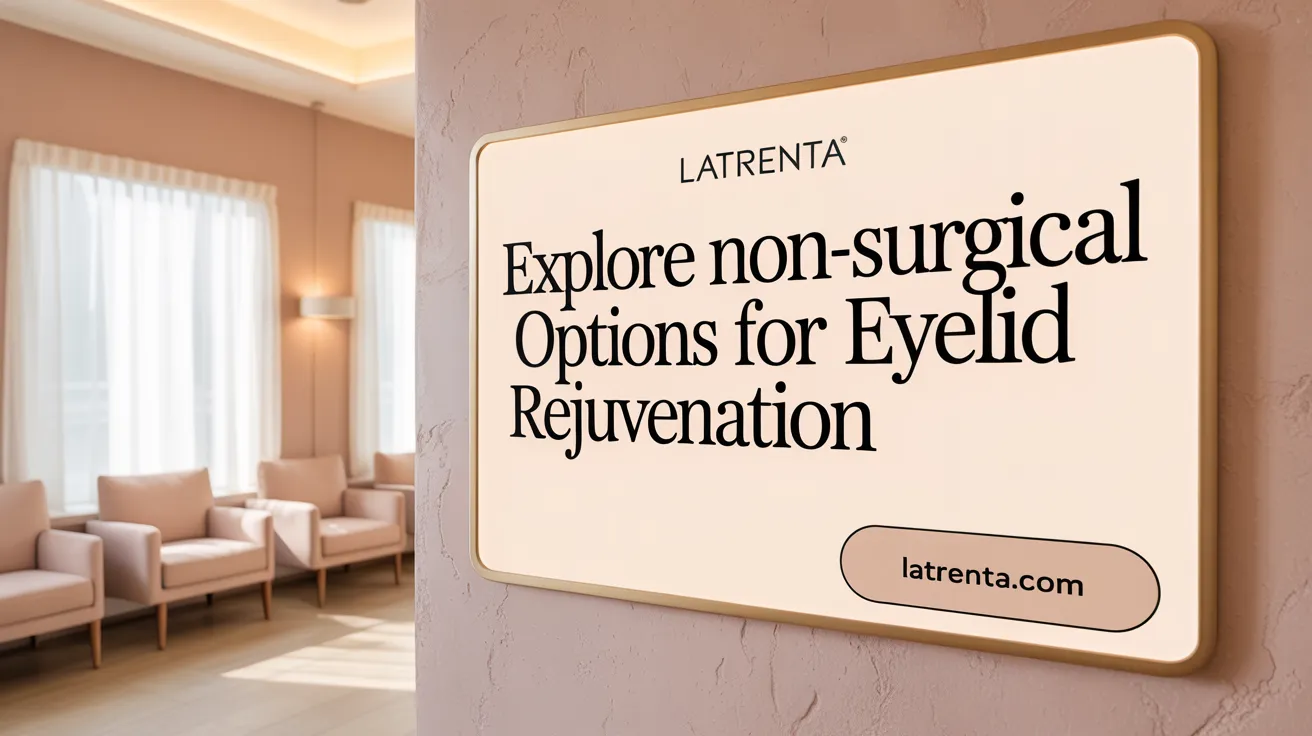Understanding the Shift Towards Minimally Invasive Eyelid Procedures
In the evolving field of aesthetic medicine, minimally invasive eyelid lift techniques offer promising alternatives to traditional surgery, blending effectiveness with reduced downtime and natural-looking results. This article explores state-of-the-art surgical and nonsurgical methods designed to rejuvenate the eyes while preserving volume and minimizing scarring, tailored for discerning patients seeking refined, personalized outcomes.
The Minimally Invasive Eyelid Lift (MINEL) Technique: A Surgical Innovation

What is the Minimally Invasive Eyelid Lift (MINEL) technique and how does it differ from traditional blepharoplasty?
The Minimally Invasive Eyelid Lift (MINEL) technique, or MINEL, is a surgical procedure designed specifically to address eyelid hooding correction without skin removal through an innovative approach. Unlike traditional upper blepharoplasty, which removes excess skin and fat, MINEL preserves the eyelid's volume by avoiding skin excision altogether. Instead, it raises the eyelid crease to a higher position to rejuvenate the eye area.
The procedure involves making 2 to 3 small skin incisions, each only 3 to 5 millimeters in length. Through these discrete openings, pretarsal tissues are carefully removed layer by layer until the levator aponeurosis is exposed. A precise surgical suture takes a bite of the levator aponeurosis and anchors it to the pretarsal orbicularis muscle using fine nylon 7/0 sutures in MINEL technique. This creates a new, natural-looking eyelid crease that lifts the eyelid without removing any skin.
Who performs the MINEL procedure and what are its main patient benefits?
MINEL is performed by experienced ophthalmologists and oculoplastic surgeons who possess specialized knowledge of the eyelid's delicate anatomical structures. This expertise ensures high precision and safety during the procedure.
Patients benefit from MINEL in several ways:
- Volume preservation: By avoiding skin removal, the eyelid retains its youthful fullness, reducing the risk of a hollowed appearance common with traditional upper blepharoplasty.
- Minimal scarring: The small incisions minimize visible scarring and trauma to surrounding tissue.
- Natural and personalized results: The repositioning of the eyelid crease creates a refreshed but natural eyelid contour.
- Reduced recovery time: Smaller incisions and less tissue disruption mean less swelling and faster healing.
These advantages make MINEL a compelling alternative for patients seeking effective eyelid rejuvenation with less invasive surgery and long-lasting results. For more information about minimally invasive cosmetic eyelid surgery, visit the linked resources.
Minimal Incision Blepharoplasty: Precision and Symmetry in Eyelid Rejuvenation

What is minimal incision blepharoplasty and how is it performed?
Minimal incision blepharoplasty is a precise, surgical technique designed to rejuvenate the upper eyelids with minimal scarring. The procedure involves four small incisions, each about 2 mm long, strategically placed on the upper eyelid. Through these tiny openings, surgeons remove selected amounts of orbicularis muscle and orbital fat excision to sculpt the eyelid.
A key part of this method is the creation of a natural-looking double eyelid crease. This is achieved by suturing the pretarsal fascia to the overlying skin, effectively stabilizing the new crease. Preoperative markings ensure symmetry, and the entire procedure is typically performed under local anesthesia to enhance patient comfort.
What outcomes and recovery can patients expect from this technique compared to traditional blepharoplasty?
Patients widely appreciate minimal incision blepharoplasty, with a reported satisfaction rate of 93%. The durability of the crease is largely attributed to the use of four fixation points during surgery. Swelling is the most common postoperative effect but usually resolves within a month.
Compared to conventional blepharoplasty, this method is less invasive, resulting in smaller scars and a faster recovery time. It is especially beneficial for younger individuals with single eyelids or for those who need revision after a previously unsuccessful blepharoplasty. The minimally invasive nature and focus on preserving natural eyelid anatomy make it an attractive alternative to traditional long-incision approaches.
Non-Surgical Eyelift Alternatives: Filling, Relaxing, and Rejuvenating

What nonsurgical options are available for eyelid lifting and rejuvenation?
Non-surgical eyelid lift options have become popular for those seeking subtle enhancement without surgery. Dermal fillers made of substances like hyaluronic acid are injected to restore volume, fill hollows, and improve the contour around the eyes. Muscle relaxers, such as Botox and Dysport, temporarily paralyze muscles that cause wrinkles and mild eyelid drooping, offering a lifted and smoother appearance. Platelet-rich plasma (PRP) involves using the patient's own blood components to rejuvenate skin tissues, stimulating healing and collagen production.
Additionally, laser treatments and radiofrequency procedures stimulate collagen growth to tighten skin and reduce wrinkles. Laser skin resurfacing removes the outer skin layers to allow newer, smoother skin to form, while radiofrequency devices like Ultherapy and ThermiTight heat deeper tissue layers for firmness and lift.
How effective are these nonsurgical treatments and what should patients expect?
These minimally invasive treatments usually take minutes to perform, involve little to no downtime, and have few risks compared to surgical options. Dermal fillers and muscle relaxers provide noticeable but temporary effects, generally requiring maintenance injections every 4 to 6 months. Laser and radiofrequency treatments promote longer-term skin remodeling but can involve temporary redness, swelling, and peeling.
While suitable for mild to moderate aging signs such as wrinkles, volume loss, and early drooping, these nonsurgical approaches typically do not achieve the dramatic or long-lasting results provided by surgical eyelid lifts. Patients seeking natural, subtle rejuvenation or unable to undergo surgery often find nonsurgical eyelid lifts an attractive and safe alternative.
Laser Blepharoplasty: Precision with Faster Recovery

What distinguishes laser blepharoplasty from conventional eyelid surgery?
Laser blepharoplasty differs from traditional eyelid surgery by using a laser to make precise incisions and remove excess skin, muscle, or fat. The laser cauterizes small blood vessels during the procedure, which minimizes bleeding, swelling, and bruising. This precision reduces tissue trauma and helps in faster healing. Typically, the incisions are placed in the natural eyelid creases or just below the lash line, significantly minimizing visible scarring. Compared to scalpel methods, laser techniques offer enhanced control and a more refined approach to eyelid rejuvenation (Laser eyelid surgery, Laser blepharoplasty benefits, Laser skin resurfacing).
What are the benefits over traditional methods?
The use of laser technology in eyelid surgery provides several benefits over conventional methods:
- Reduced bleeding due to cauterization
- Less postoperative swelling and bruising
- Shorter recovery times
- Greater precision for tissue removal
- Minimized visible scarring
- Ability to customize the procedure to target specific aging concerns
These advantages contribute to an overall more comfortable patient experience and natural-looking, long-lasting results (Laser eyelid surgery benefits, Blepharoplasty surgical procedure, Minimally invasive blepharoplasty technique).
What is the typical recovery process following laser eyelid surgery?
After laser blepharoplasty, most patients experience milder bruising and swelling compared to traditional surgery, allowing many to return to work within 2 to 4 days. Postoperative care includes applying prescribed eye drops or ointments, using ice packs to reduce swelling, keeping the head elevated, and protecting the eyes from sun exposure. Patients are advised to avoid strenuous physical activities during the initial recovery phase. While visible healing occurs relatively quickly, full recovery and scar maturation may take several weeks. The laser approach accelerates healing, making it a preferred option for patients seeking a quicker return to daily activities with effective eyelid rejuvenation (Recovery timeline for lower blepharoplasty, Blepharoplasty recovery process, How long is recovery from an eyelid lift?).
Rapid Recovery Lower Blepharoplasty: Transconjunctival Approach
What is transconjunctival lower blepharoplasty and how does it facilitate rapid recovery?
Transconjunctival lower blepharoplasty is a surgical technique where the incision is made inside the lower eyelid rather than on the skin. This allows surgeons to remove or reposition excess fat deposits without removing skin. Because the procedure avoids an external skin incision, it minimizes visible scarring and reduces trauma to the surrounding tissues.
This internal approach leads to significantly less bruising and swelling compared to traditional methods. It is ideal for patients who have puffiness due to fat prolapse but still maintain good skin elasticity. The preservation of skin integrity helps maintain natural appearance and accelerates the healing process. For detailed insights, see Rapid recovery from eyelid surgery and Eyelid surgery techniques.
Why is surgical expertise important and what recovery can patients expect?
Successful outcomes from transconjunctival blepharoplasty depend heavily on the surgeon's expertise. Board-certified oculoplastic surgeons with specialized training in this procedure are best equipped to minimize risks and tailor the surgery for natural, balanced results. Learn about Choosing a board-certified cosmetic surgeon for blepharoplasty procedures.
Postoperative care includes applying cold compresses, elevating the head during rest, and avoiding strenuous activities to reduce swelling. Many patients notice visible improvements within one week of surgery, a much faster recovery than traditional lower eyelid operations. Full healing continues over several weeks, allowing patients to return to their routines promptly while enjoying refreshed and youthful under-eye contours. For recovery details, refer to Lower blepharoplasty recovery timeline and How long is recovery from an eyelid lift?.
Comprehensive Eyelid Rejuvenation: Combining Techniques for Personalized Outcomes

What surgical variations exist in eyelid lift procedures and when are they indicated?
Eyelid surgery, or blepharoplasty, offers multiple options tailored to individual needs. Upper blepharoplasty targets excess skin, fat, and muscle through incisions in the natural crease of the upper eyelid to refresh eye appearance and improve eyelid function. Lower blepharoplasty can be done via transcutaneous approaches that remove skin and fat or transconjunctival incisions inside the eyelid, ideal for fat removal without skin excision.
Muscle strengthening techniques like ptosis repair address droopy upper eyelids that affect vision. Fat preservation or repositioning avoids hollow eye appearance by relocating fat rather than removing it, maintaining natural volume. The SOOF (sub-orbicularis oculi fat) lift raises fat beneath the eyelid to correct midface hollowness.
Canthoplasty or canthopexy tightens the outer eyelid corner to prevent eyelid drooping and improve eye shape. The choice among these methods depends on the patient's anatomy, age-related changes, presence of fat prolapse, skin laxity, and aesthetic goals.
How can additional procedures and postoperative care enhance eyelid rejuvenation?
To achieve balanced facial rejuvenation, eyelid surgery is often combined with complementary procedures such as brow lifts or facelifts. Volume augmentation through fat grafting or fillers further restores youthful contours. Fat preservation and repositioning during surgery promote natural, long-lasting results.
Postoperative care plays a critical role in recovery and outcome longevity. Patients should follow surgeons’ instructions carefully, which include protecting eyes from sun exposure, properly applying ointments or eye drops, elevating the head, and avoiding strenuous activities initially. Resources for recovery after eyelid surgery provide detailed guidance.
Modern minimally invasive and nonsurgical adjuncts like Botox, laser resurfacing, or fractional CO2 treatments can offer subtle enhancements and skin tightening. These options ensure customizable care plans that suit individual needs while minimizing downtime and risks.
Together, these strategies help patients achieve natural, personalized eyelid rejuvenation with improved function and aesthetics.
The Future of Eyelid Rejuvenation: Blending Innovation with Individualized Care
Minimally invasive eyelid lift techniques represent a pivotal advancement in aesthetic surgery, offering options that balance efficacy, safety, and rapid recovery. Surgical innovations like the MINEL procedure and minimal incision blepharoplasty prioritize natural volume preservation and precision, while nonsurgical treatments provide accessible alternatives for milder concerns. Laser and transconjunctival approaches further reduce downtime, broadening patient suitability. Ultimately, choosing the right technique involves expert evaluation by double board-certified surgeons who tailor interventions to individual anatomy and goals. As technologies and methods evolve, patients can expect increasingly refined, long-lasting results that enhance appearance while honoring each person’s unique beauty.
